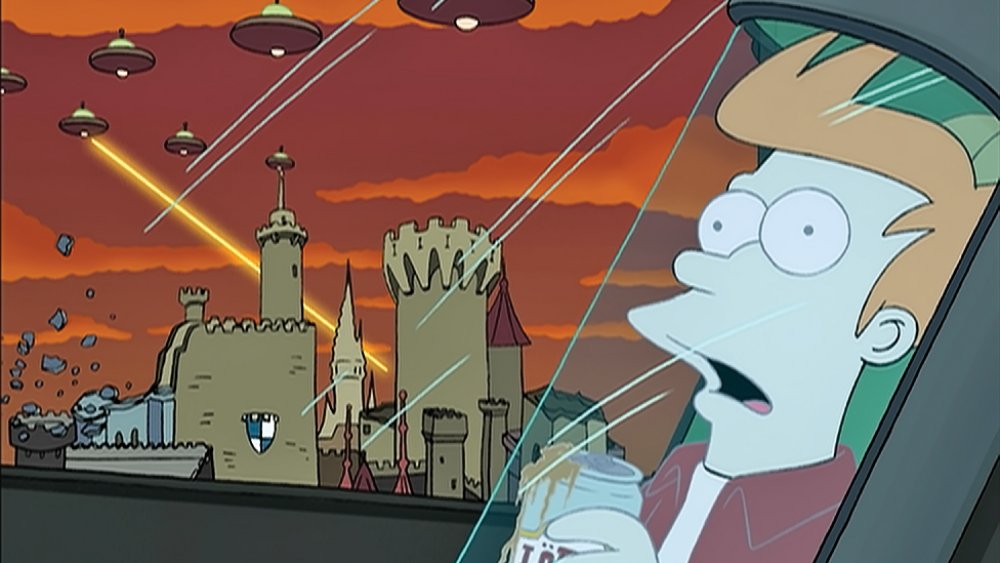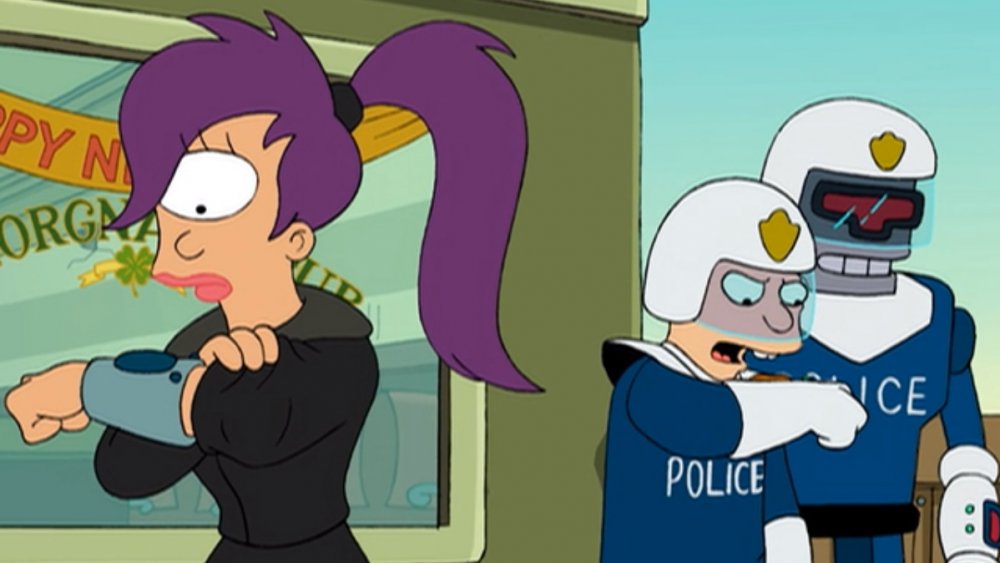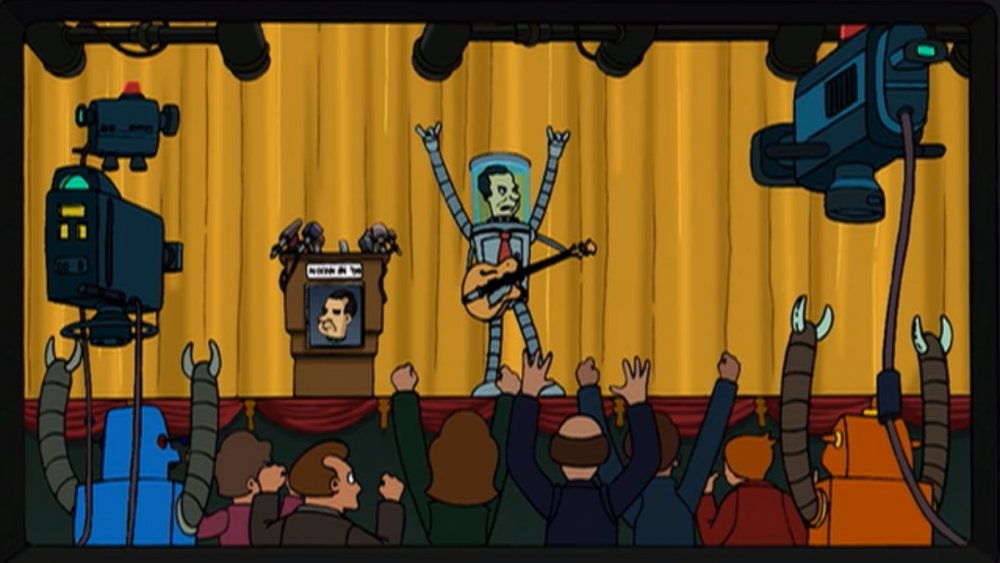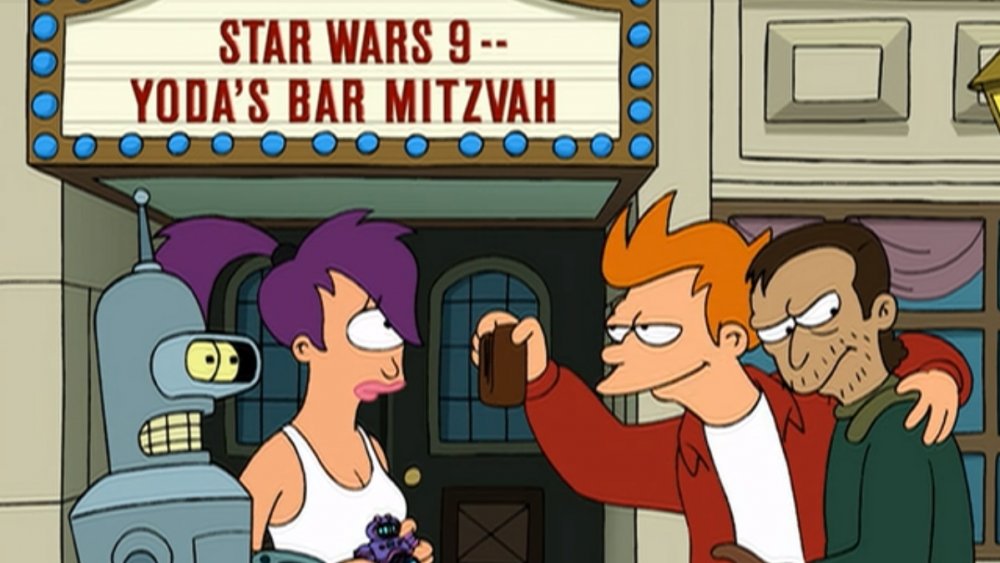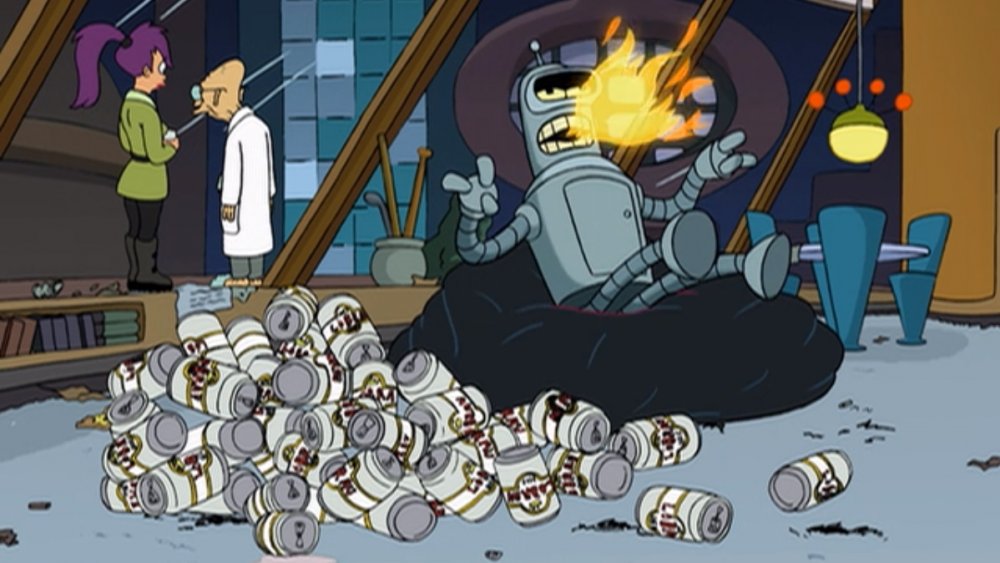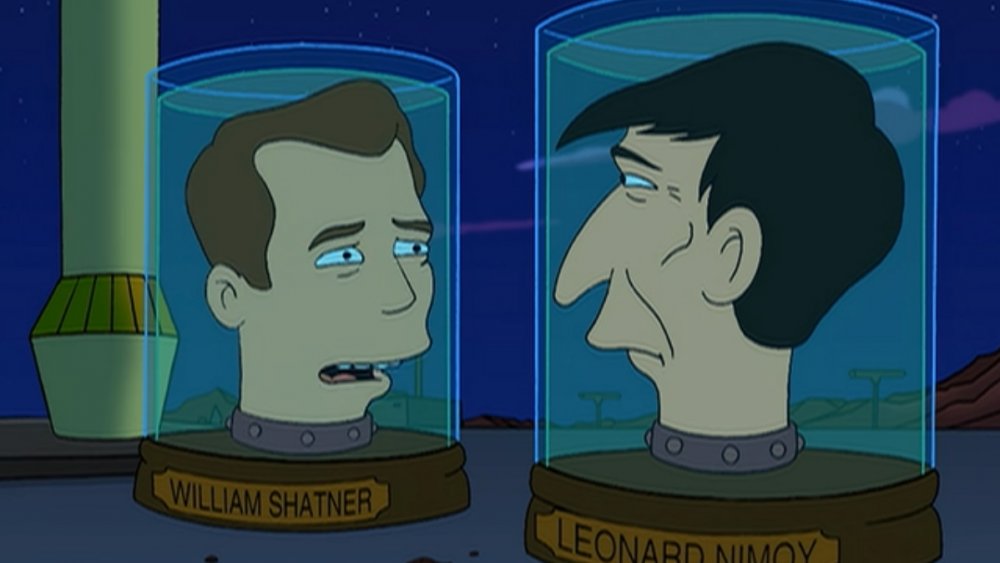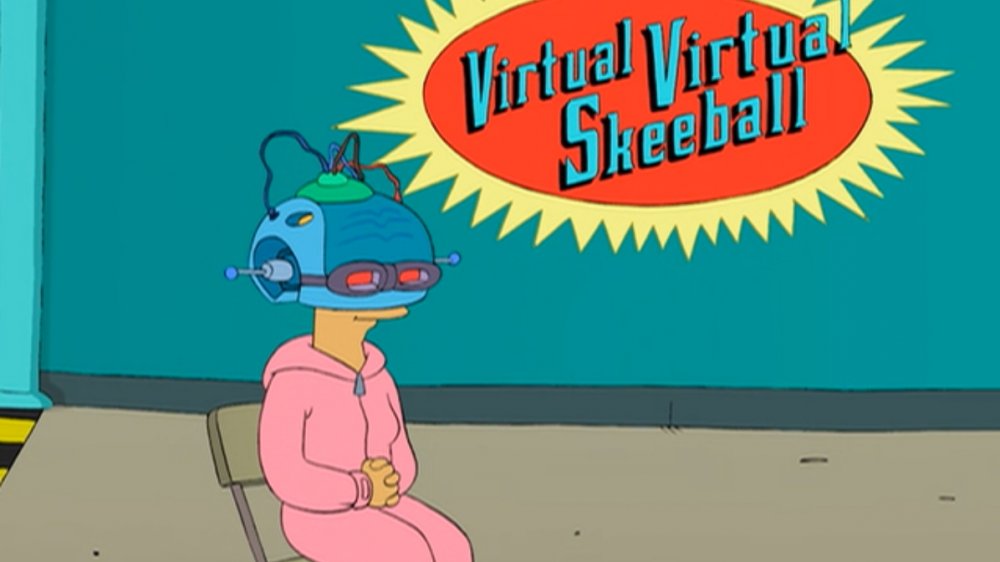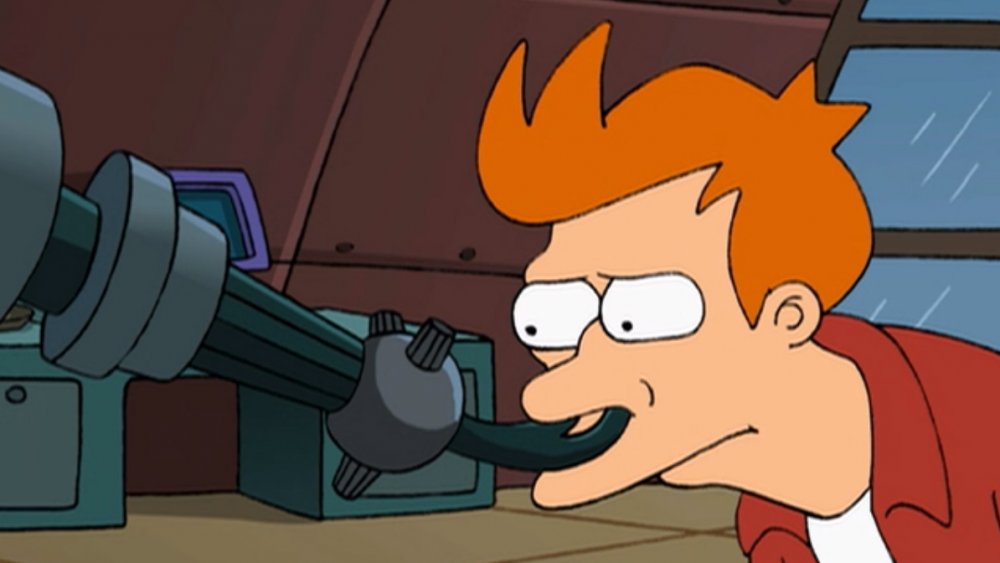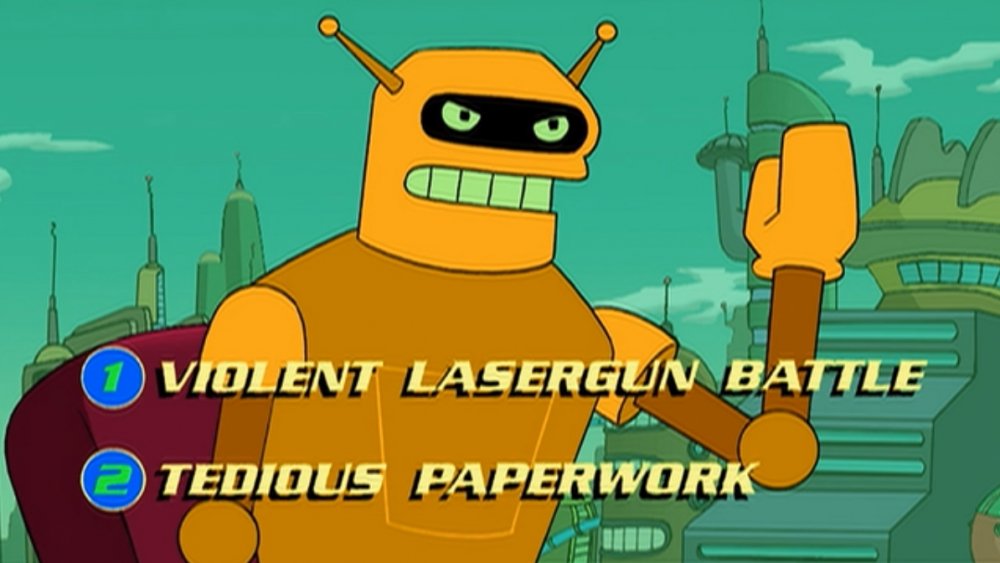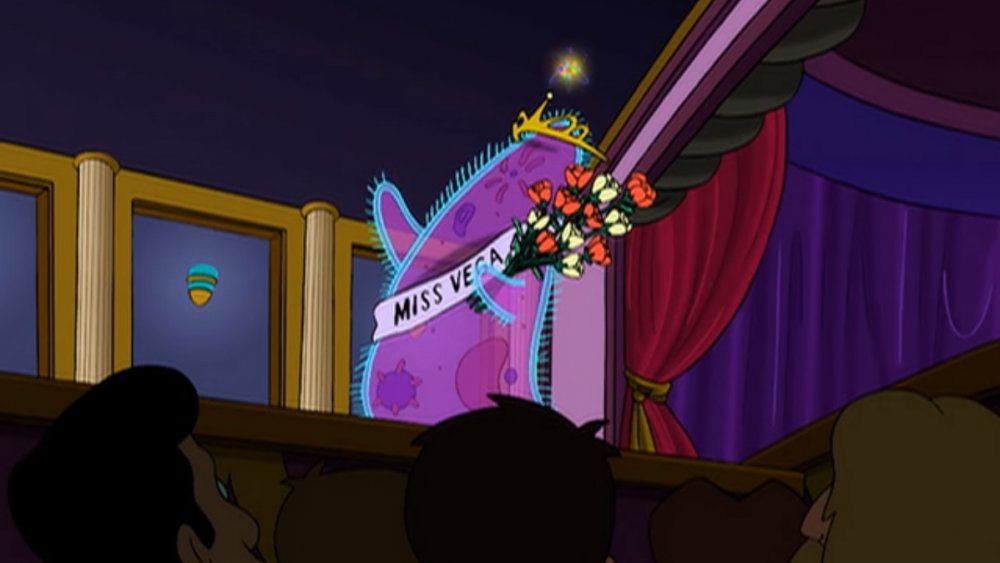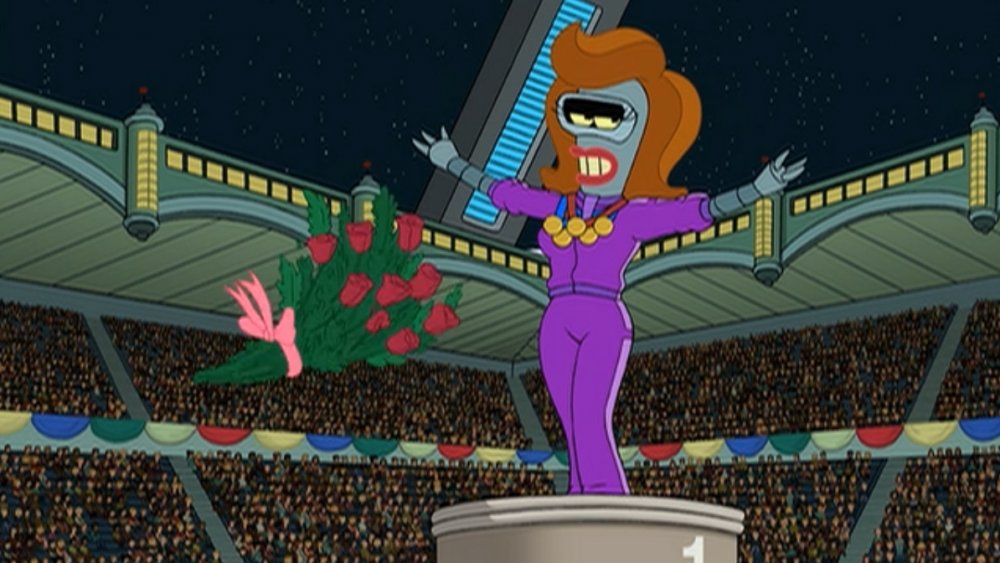Times Futurama Freakishly Predicted The Future
Welcome to the world of tomorrow! Premiering in 1999, Futurama follows the exploits of Phillip J. Fry, a 20th century slacker who gets cryonically frozen and awakens in the year 3000. Though never achieving the level of success of its co-creator's previous project, The Simpsons, Futurama was a cult hit to such a degree that, after it was cancelled by Fox, it was picked up by other networks multiple times — first by Cartoon Network for reruns on Adult Swim, then for new episodes on Comedy Central.
Fittingly for a show about the future, Futurama was ahead of the curve in all sorts of ways. It mixed hand-drawn and computer animation long before that was commonplace. It was full of hidden secrets in the vein of later lore-dense cartoons like Steven Universe, Gravity Falls, or Rick and Morty. But the most uncanny way that Futurama was ahead its time was in how its stories often predicted real life technological developments, social trends, and news stories.
Perhaps this is because Futurama has a relatively even-handed opinion of humanity, combined with an appropriate dash of absurdity. It's neither utopia nor dystopia. The doors all whoosh open like Star Trek, but none of them work reliably. We can enter the internet like Tron, but it's full of ads. People are still people, and the news is consistently far stranger than anyone could have predicted. Who would have thought that a world full of alcohol-powered robots and Smell-O-Scopes would end up resembling our own? Here's all the times that Futurama freakishly predicted the future.
Futurama's wrist computers are just smartwatches
One of the most ubiquitous pieces of technology in the world of Futurama is the wrist-mounted computer. Though they never get an official name, Leela typically refers to hers with some variant of the phrase "wrist thingy." Leela has used her wrist thingy as a phone, a clock, an internet browser, a video game console, an atmospheric analyzer, a laser gun, a tissue dispenser, and a remote control for the Planet Express ship.
Ever since the days of The Jetsons, we have longed for wristwatch computers, but when Futurama premiered, they were still a distant dream. The closest thing we had at the time was Samsung's SPH-WP10, a wrist-mounted cell phone that weighed 50 grams and had a battery life of 90 minutes.
Over the past few years though, this dream has more or less come true, with smartwatches like the Apple Watch that can now approximate many of the functions of a smart phone. Of course, unlike Leela's wrist thingy, the Apple Watch can't record someone rapping and then analyze the success rate of their rhyme-busting.
Futurama's floating drone cameras
In many ways, our modern world doesn't look all that different from 1999, the year when Futurama first premiered. Most of our technological progress in the past two decades has been in the realm of computers, rather than jetpacks and flying cars. However, we have had one major change to the skies of our cities, and that's the development of quadcopter drones.
In recent years, technology surrounding unmanned aerial vehicles has progressed by leaps and bounds, leading to widespread availability of cheap quadcopter drones for pretty much anyone who wants one. The applications of these drones so far has been numerous. Militaries and law enforcement have found them useful for surveillance and reconnaissance, independent filmmakers use them as an alternative way to get what would otherwise be expensive "helicopter shots," and they've even inspired the creation of new sports, such as drone racing.
Believe it or not, Futurama kind of called this one. Floating camera drones appear all throughout Futurama in lieu of human camera operators, especially in TV-centric episodes like "A Head in the Polls." One difference from how UAVs have been used in real life, however, is that apparently no one in the Futurama-verse figured out that drones can be used to make deliveries. It's a good thing, too, or else the Planet Express crew might be out of a job.
Star Wars: Episode IX
In the episode "The Lesser of Two Evils," Fry, Leela, and Bender visit Past-o-Rama, a theme park that is ostensibly supposed to accurately recreate late 20th/early 21st century New York. However, in keeping with the show's long-running joke that no one in the year 3000 has a good understanding of history, the park is full of anachronisms, such as Cowboys hunting woolly mammoths and Albert Einstein disco dancing with Hammurabi.
The only clearly predictive element of scenery is the marquee at the theater, which advertises "Star Wars 9 — Yoda's Bar Mitzvah." When "The Lesser of Two Evils" first aired, the newest Star Wars film to come out was Star Wars: Episode I – The Phantom Menace, and given how poorly received that film was, the thought that we'd eventually get an Episode IX was far from certain. So kudos to Futurama for calling this one! We are going to have to deduct a few points though, because it looks like they did get the name of the film *slightly* wrong. On the other hand, the idea of a young Yoda turned out eerily prescient in itself.
This isn't the only time that one of Futurama's joke movies ended up actually getting made. In the episode "A Fishful of Dollars," Fry meets the head of Pamela Anderson, who tells him that she starred in "Baywatch: The Movie," and 18 years later, a theatrical Baywatch film did, in fact, hit theaters. It was not, as Futurama predicted, "the first movie to be shot entirely in slow-motion," and Pamela Anderson didn't win an Oscar for it, but she did have a cameo at the end.
Beer-powered machines
In the world of Futurama, robots like Bender are powered by alcohol. In fact, in the episode "I, Roommate," we learn that Bender actually gets drunk from not drinking, since robots display symptoms similar to drunkenness when their power level is low. But this is clearly just a bit of absurd humor, right? Out of all the wacky elements from Futurama's setting that might actually come to pass, there's no way that we're going to actually get machines that run on beer, will we?
We present to you the newest innovation in automotive fuel: beer. Created by New Zealand-based brewery DB Export, Brewtroleum is an ethanol fuel made from the yeast and grain waste products left over by the brewing process.
Finding leftover bits of biomass from other industries and processing those waste products into ethanol fuel could be the future of biofuels. It's frequently less work, and according to some reports, growing crops explicitly for use as biofuels could contribute to food shortages.
So if you want the full Futurama experience of sharing a beer with one of your robot friends, it turns out that finding the fuel is easy. The hard part is finding a robot that runs on diesel. You could try the BigDog quadrupedal robot that was developed by Boston Dynamics back in 2005, which does have a gas-powered engine. But if you ask us, feeding beer to a dog seems wrong, even a robot one.
Was Futurama a-head of the curve on celebrity immortality?
Even though Futurama takes place in the 31st century, most of the prominent celebrities in that world are the same ones we have today. However, in most cases, all that's left of them is their heads, which are kept alive in jars full of liquid. The sorts of people whose heads are deemed worthy of this highly indignant form of resurrection varies wildly from historical figures like Napoleon and Abraham Lincoln to 20th century celebs like Cindy Crawford and the Beastie Boys. We might not have cracked the science of preserving heads in jars yet in our century, but through new advances in computer-generated imagery, we are fast approaching a world where celebrities never die.
Ever since the debut of the infamous Tupac "hologram," the genie has been out of the bottle in terms of using technology to virtually resurrect the dead. In Rogue One, motion capture and CGI meant that the late Peter Cushing could reprise his role as Grand Moff Tarkin, and a digitally de-aged Carrie Fisher could make a cameo as Leia. After Paul Walker's unexpected death during the production of Furious 7, a mixture of visual effects techniques recreated his likeness for the last few scenes he was unavailable to film. An especially controversial recent example is the virtual casting of James Dean in the film Finding Jack. Say what you want about preserving a head in a jar — at least in that case the dead celebrity can voice an opinion.
Futurama's terrifyingly dull prediction about virtual mundanity
Futurama wasn't the first work of science fiction to posit using computers to create immersive simulated experiences. Novels like Neuromancer and films like Brainstorm told stories about virtual reality decades earlier. However, Futurama seems to be the first work of fiction to predict how quickly this technology would be used to recreate and gamify totally mundane experiences.
Futurama first presented its take on VR in the episode "The Series Has Landed." When the Planet Express crew visits an amusement park on the moon to deliver a package, they swing by a video arcade to play some games. First, we see someone playing Skeeball. Then, we see someone playing Virtual Skeeball, wearing a VR headset — which looks a lot like an Oculus Rift — and mimicking the motion of throwing a skeeball. And finally, we see someone playing Virtual Virtual Skeeball, wearing a VR headset and just sitting in a chair, not doing anything at all.
A couple decades later, a pair of games shockingly similar to Virtual Virtual Skeeball come along in the form of Job Simulator and its sequel, Vacation Simulator. These comedic games use the magic of Oculus Rift technology to create immersive simulations of completely mundane situations. These sorts of tongue-in-cheek games obviously aren't the only thing that virtual reality is being used for, but they do speak to a larger cultural trend that Futurama predicted — no technology, no matter how awe-inspiring, can keep blowing our minds forever. Eventually, everything becomes a punchline.
Futurama caught a whiff of the future with the Smell-O-Scope
Professor Farnsworth has created a lot of iconic inventions over the years, such as the Cool-O-Meter, the What-If Machine, and the Fing-Longer. Perhaps his most memorable is the Smell-O-Scope, which allows its users to smell objects at an astronomical scale. As Farsworth puts it, "If a dog craps anywhere in the universe, you can bet I won't be out of the loop."
As silly as this device may be, it's not too far off from a real-world invention known as the Nasal Ranger. Unfortunately, the Nasal Ranger can't smell objects at long ranges — if you aren't in the same space as a given odor, with actual bits of it entering your nose, there's no way to smell it. However, this "field olfactometer" can be used by a trained operator to quantify just how strong a smell really is.
The Nasal Ranger allows its user to inhale ambient air filtered to varying degrees, as determined by an adjustable dial. By changing the tolerance of the filters, an operator can discover just how much a stench needs to be diluted before it is no longer offensive. According to a segment of Modern Marvels all about the Nasal Ranger, any scent that can still be detected when one part of it is diluted with 15 parts clean air is "a nuisance."
As cool as the Nasal Ranger is, we're a little disappointed that its creators opted to measure stinkiness with dilution ratios, instead of the Smell-O-Scope's far more scientifically exact "Funkometer."
Celebrity sex robots
In "I Dated a Robot," Fry discovers a service that sells robotic companions with the personalities and appearances of celebrities. But shortly after Fry purchases one based on Lucy Liu, circa 2003, he learns a terrible truth. This company is programming its robots by kidnapping real celebrity heads and forcefully scanning their brains. In the end, Fry rescues the real Lucy Liu and the other kidnapped celebrity heads. He then destroys his unlawfully acquired Liu-bot, in keeping with actual Lucy Liu's wishes.
Though realistic sex robots are still a ways off, we're getting closer every year. Realbotix recently released a version of the RealDoll sex doll with a customizable robotic head capable of speech and limited movement. As a joke, comedian Whitney Cummings purchased one customized to look like herself, and incorporated the robot into a stand-up special. Perhaps predictably, shortly thereafter Realbotix reported a deluge of requests from customers for Whitney Cummings sex robots. However, Realbotix rejected these requests, since they didn't own Cummings' likeness.
Another form of erotic entertainment this episode unintentionally predicts is deepfake pornography. The latest trend on many pornographic streaming sites are videos that have been edited with facial replacement technology to impose celebrities' faces onto the bodies of porn actors without the consent of the given celebrities. So although real sex robot companies seem to have some respect for the image rights of real people, deepfakers seem to have moral standards that are much more in keeping with the makers of Fry's Lucy Liu-bot.
Futurama imagined interactive movies before the rise of streaming
When the crew goes to watch "All My Circuits: The Movie" in the episode "Raging Bender," we see that movies have changed a bit since the 21st century. As robot businessman Calculon is finishing some paperwork, he receives a phone call alerting him that "a fight scene has broken out at the special effects warehouse." An announcer then says, "If you want Calculon to race to the laser gun battle in his hover Ferrari, press 1. If you want Calculon to double-check his paperwork, press 2." The audience selects "2," and Calculon spends the next few minutes sitting at his desk, flipping through papers.
The promise of interactive films has been on the frontier of cinema for decades. The first interactive movie was the 1967 Czech film Kinoautomat, but surprisingly few films have followed in Kinoautomat's tracks. Since the premiere of "Raging Bender," much of the hype around interactive films has been realized in narrative-driven video games like Her Story, The Stanley Parable, or the work of Telltale Games.
Black Mirror recently experimented with the potential of streaming services to create interactive fiction with its mind-bending special "Bandersnatch." It was, like many interactive movies, praised for its novelty, but criticized for not having much depth beyond its high concept. Perhaps artists have yet to figure out what to do with this new art form, but for now, this is a rare case of a science fiction technology that we are fully capable of realizing today — we just choose not to.
An accidental crowning at the Miss Universe pageant
One instance of Futurama's uncanny prescience came in an episode that ended up predicting not a technological trend, but a news story. In "The Lesser of Two Evils," Leela, Fry, and Bender find themselves at the Miss Universe pageant. As the crew is watching the show, they see that presenting the winner is Leela's ex, Zapp Brannigan. When Zapp notices Leela as he opens the envelope, he calls out her name in surprise, not expecting to see her there. However, the pageant staff misinterprets this as Zapp announcing Leela as the winner, so they drag her on stage and give her flowers and a crown. Moments later, Zapp speaks up, saying that the true winner is Miss Vega 4. Leela is stripped of her crown and flowers, and they are given to the real Miss Universe, a giant purple amoeba.
In 2015, the actual Miss Universe pageant had a mix-up of its own. Moments after Miss Colombia was crowned Miss Universe, comedian Steve Harvey, who was in charge of presenting the winner, realized that he had misread the piece of paper he was given and accidentally named the wrong winner. When he started to explain, the audience thought he was kidding around at first, but he clarified that this was no joke. The actual winner was Miss Philippines. It was a fiasco truly worthy of an animated sitcom, but given that this was happening in the real world, everyone involved found it a whole lot less funny.
Outrage over trans athletes
Normally, Futurama episodes do a good job of predicting societal trends and engaging with these issues intelligently. "Bend Her" is not such an episode. Although it correctly predicted that trans people might start openly competing in professional sports in the future, and that some people might have a problem with that, this episode is so offensive that we hesitate to even summarize it. It's the proposed nightmare scenario of every transphobic bigot brought to life: an amoral male athlete who isn't trans, Bender, undergoes gender reassignment surgery so that he can compete against women and have a leg-up on the competition. Along the way, it treats the very idea of being trans as a hilarious joke, and reinforces every tired stereotype about gender in existence.
Integrating trans people into professional sports is clearly a complicated issue. Most experts agree that trans women are not a threat to women's sports, but the increased visibility of trans and non-binary people in recent years does raise the questions about the role of gender segregation in sports, and whether or not we want to re-evaluate how we categorize athletes in the future. In the meantime, it has been legal for trans people to compete in the Olympics since 2003, and no one has attempted to abuse the system in the way in the way that some people fear, so chill out.
Stories like this one are not harmless fun. They perpetuate harmful myths that get people killed. We love you with all our hearts Futurama, and normally you can see the future coming like no one else, but in this case, you ended up on the wrong side of history.
